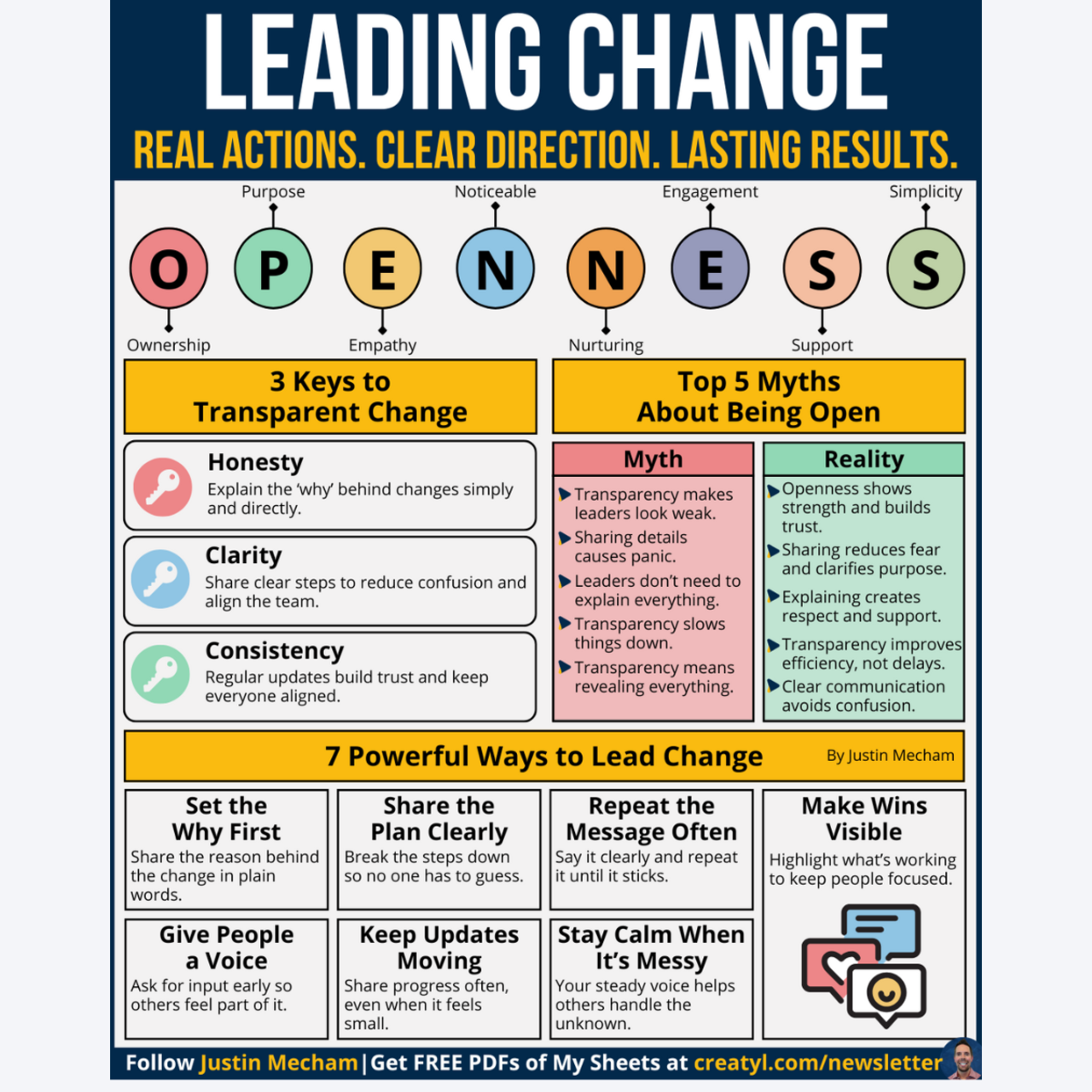Click Here to Download Today's Infographic
The Real Problem Isn’t Change. It’s Silence.
Change is never the real problem.
Silence is.
Most teams don’t crumble when a new direction is introduced. They fall apart when they’re left guessing. When there’s no why.
No clarity. No update. Just a calendar invite, a new dashboard, or a sudden shift with no context.
That’s what builds resistance—not the change itself.
Because in the absence of information, people don’t assume the best. They fill the silence with fear. They brace for impact. They start imagining the worst-case scenario.
And eventually, they disengage. Quietly at first—then all at once.
But it doesn’t have to go that way.
What Lasting Change Really Takes
The key to lasting change isn’t pressure.
It’s clarity.
And that requires three things:
Honesty
Say what’s changing—and why. Even if it’s messy. Even if you don’t have all the answers. Silence doesn’t make you look more prepared. It makes you look unsure.
Clarity
Lay out the plan in plain words. No corporate speak. No sugarcoating. Just real steps. Let people see the full picture—not just the polished slide deck.
Consistency
Keep people updated—especially when nothing is changing. No news should still be news. Because when people are left out, they start checking out.
These three ingredients are what build alignment before resistance even shows up.
Because teams don’t need perfection. They need to feel seen, trusted, and informed.
5 Transparency Myths That Keep Leaders Stuck
Still worried about being “too transparent”? Let’s break down five common myths:
“Transparency makes leaders look weak.”
Truth: It builds strength and trust. People follow what they understand, not what looks polished.
“Sharing details causes panic.”
Truth: Silence causes more. When people don’t know, they assume the worst.
“Leaders shouldn’t have to explain everything.”
Truth: You don’t. But some things need clarity—especially if they impact people’s work, time, or future.
“Transparency slows things down.”
Truth: Confusion causes delays. Clear direction gets people aligned faster.
“You have to reveal everything.”
Truth: You don’t. You just have to be honest about what you can share—and why some things are still unknown.
The best leaders aren’t the ones with all the answers. They’re the ones who say what they know—and let people come along for the ride.
Strong Rollouts Don’t End with the Announcement
Don’t stop once the plan is shared. That’s just the start.
If you want change to stick, here’s what the best leaders do after the rollout:
- Deliver clear updates as things move. Even a weekly one-liner keeps momentum.
- Celebrate quick wins, even if small. Progress needs to be seen to be felt.
- Repeat the vision so people remember what matters. Reminders create direction.
- Ask for feedback and actually listen. Teams stay engaged when they feel heard.
- Show progress often and publicly. Visibility builds energy.
- Stay calm, especially when the unknown shows up. Confidence is contagious.
Change without clarity leads to chaos. But change with direction leads to better decisions, faster alignment, and stronger trust.
Your Go-To Script When Leading Change
Not sure how to communicate the shift?
Start with four simple lines:
“Here’s what’s changing…”
“Here’s why it matters…”
“Here’s what you can expect next…”
“Here’s where you fit…”
Those four lines alone can change the tone of an entire rollout.
Don’t wait for a perfect memo or the right time. Say what’s real, show people where they fit, and keep it moving.
A Real-World Leadership Example That Changed Everything
A mid-sized tech company was going through a restructuring. Teams were merging. Roles were shifting. The leadership team believed they were being careful—holding back information until every detail was finalized.
But the silence created panic. People feared layoffs. Productivity dropped. Whispers turned into rumors.
That’s when the head of operations changed direction. They sent a single message with just four sections:
“Here’s what’s changing…”
“Here’s why it matters…”
“Here’s what you can expect next…”
“Here’s where you fit…”
They didn’t have all the answers yet—but they were honest about that too.
Then they followed it up weekly with short, clear updates—even when nothing had changed.
The result? Engagement rose. Managers felt more trusted. Team members stopped guessing and started planning.
The change still came with challenges. But trust didn’t break.
Real Tools That Help Lead Real Change
Podcast — Dare to Lead with Brené Brown
Brown’s show dives into real stories of transparent leadership—what it sounds like when executives admit limits, spell out the “why,” and keep teams engaged through messy pivots. Episodes mix solo coaching with unfiltered conversations from CEOs who turned openness into momentum.
Available on Apple Podcasts
AI Tool — Microsoft 365 Copilot for Change Management
Microsoft’s Copilot now includes built-in change-management templates and prompt libraries. Leaders can draft clear “why” memos, timeline visuals, and Q&A updates in seconds, then push them to Teams channels for instant feedback—removing the lag that creates silence and fear. Early internal rollouts show faster alignment and fewer missed deadlines during reorganizations.
TV Show — New Amsterdam (Created by David Schulner)
This medical drama is a masterclass in leading with clarity, empathy, and bold change. Dr. Max Goodwin, the new medical director, steps into a legacy system and asks one thing: “How can I help?” He faces bureaucracy head-on, explains decisions out loud, includes his team in the process, and keeps everyone focused on what matters. It’s a powerful example of what leading change with honesty and consistency looks like.
Transparency Is the Toughest, Truest KPI
Ask yourself this:
- If your team had to explain tomorrow’s plan without you in the room, could they?
- If a new hire joined today, would they understand the ‘why’ before the ‘what’?
- If gossip vanished overnight, would information flow actually shrink—or stay the same?
If the honest answer rattles you, you’re not alone. Almost every leader discovers that the biggest threat to momentum isn’t resistance—it’s unanswered questions.
People will take on hard work, long hours, even scary pivots—as long as they know what game they’re playing and why the score matters.
So, the next time you worry that transparency might show weakness, remember: silence is a story factory. And the stories it produces rarely end in loyalty.
Say the plan. Show the reason. Invite people into the process. When you do, you don’t just move projects—you move hearts, and those stay committed far longer than any mandate.
Get the Infographic
Want the full framework in one simple visual? Download the “Leading Change” infographic in PDF format and share it with your team.




